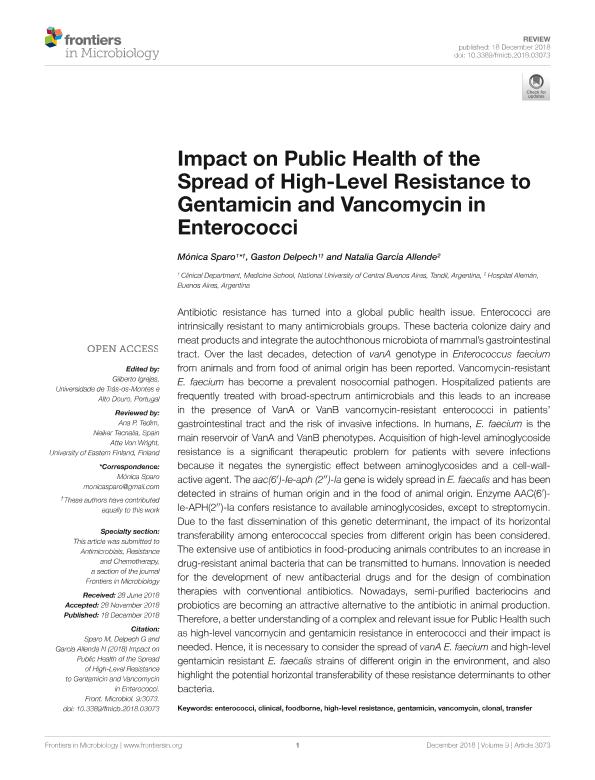Mostrar el registro sencillo del ítem
dc.contributor.author
Sparo, Mónica Delfina

dc.contributor.author
Delpech, Gastón

dc.contributor.author
García Allende, Natalia
dc.date.available
2019-11-26T14:35:27Z
dc.date.issued
2018-03
dc.identifier.citation
Sparo, Mónica Delfina; Delpech, Gastón; García Allende, Natalia ; Impact on public health of the spread of high-level resistance to gentamicin and vancomycin in enterococci; Frontiers Research Foundation; Frontiers in Microbiology; 9; 3-2018; 1-10
dc.identifier.uri
http://hdl.handle.net/11336/90468
dc.description.abstract
Antibiotic resistance has turned into a global public health issue. Enterococci are intrinsically resistant to many antimicrobials groups. These bacteria colonize dairy and meat products and integrate the autochthonous microbiota of mammal’s gastrointestinal tract. Over the last decades, detection of vanA genotype in Enterococcus faecium from animals and from food of animal origin has been reported. Vancomycin-resistant E. faecium has become a prevalent nosocomial pathogen. Hospitalized patients are frequently treated with broad-spectrum antimicrobials and this leads to an increase in the presence of VanA or VanB vancomycin-resistant enterococci in patients’ gastrointestinal tract and the risk of invasive infections. In humans, E. faecium is the main reservoir of VanA and VanB phenotypes. Acquisition of high-level aminoglycoside resistance is a significant therapeutic problem for patients with severe infections because it negates the synergistic effect between aminoglycosides and a cell-wall-active agent. The aac(60)-Ie-aph (200)-Ia gene is widely spread in E. faecalis and has been detected in strains of human origin and in the food of animal origin. Enzyme AAC(60)-Ie-APH(200)-Ia confers resistance to available aminoglycosides, except to streptomycin. Due to the fast dissemination of this genetic determinant, the impact of its horizontal transferability among enterococcal species from different origin has been considered. The extensive use of antibiotics in food-producing animals contributes to an increase in drug-resistant animal bacteria that can be transmitted to humans. Innovation is needed for the development of new antibacterial drugs and for the design of combination therapies with conventional antibiotics. Nowadays, semi-purified bacteriocins and probiotics are becoming an attractive alternative to the antibiotic in animal production. Therefore, a better understanding of a complex and relevant issue for Public Health such as high-level vancomycin and gentamicin resistance in enterococci and their impact is needed. Hence, it is necessary to consider the spread of vanA E. faecium and high-level gentamicin resistant E. faecalis strains of different origin in the environment, and also highlight the potential horizontal transferability of these resistance determinants to other bacteria.
dc.format
application/pdf
dc.language.iso
eng
dc.publisher
Frontiers Research Foundation

dc.rights
info:eu-repo/semantics/openAccess
dc.rights.uri
https://creativecommons.org/licenses/by-nc-sa/2.5/ar/
dc.subject
CLINICAL
dc.subject
CLONAL
dc.subject
ENTEROCOCCI
dc.subject
FOODBORNE
dc.subject
GENTAMICIN
dc.subject
HIGH-LEVEL RESISTANCE
dc.subject
TRANSFER
dc.subject
VANCOMYCIN
dc.subject.classification
Biología Celular, Microbiología

dc.subject.classification
Ciencias Biológicas

dc.subject.classification
CIENCIAS NATURALES Y EXACTAS

dc.title
Impact on public health of the spread of high-level resistance to gentamicin and vancomycin in enterococci
dc.type
info:eu-repo/semantics/article
dc.type
info:ar-repo/semantics/artículo
dc.type
info:eu-repo/semantics/publishedVersion
dc.date.updated
2019-10-23T21:34:32Z
dc.identifier.eissn
2235-2988
dc.journal.volume
9
dc.journal.pagination
1-10
dc.journal.pais
Suiza

dc.journal.ciudad
Lausanne
dc.description.fil
Fil: Sparo, Mónica Delfina. Consejo Nacional de Investigaciones Científicas y Técnicas. Centro Científico Tecnológico Conicet - Tandil. Centro de Investigación Veterinaria de Tandil. Universidad Nacional del Centro de la Provincia de Buenos Aires. Centro de Investigación Veterinaria de Tandil. Provincia de Buenos Aires. Gobernación. Comision de Investigaciones Científicas. Centro de Investigación Veterinaria de Tandil; Argentina
dc.description.fil
Fil: Delpech, Gastón. Consejo Nacional de Investigaciones Científicas y Técnicas. Centro Científico Tecnológico Conicet - Tandil. Centro de Investigación Veterinaria de Tandil. Universidad Nacional del Centro de la Provincia de Buenos Aires. Centro de Investigación Veterinaria de Tandil. Provincia de Buenos Aires. Gobernación. Comision de Investigaciones Científicas. Centro de Investigación Veterinaria de Tandil; Argentina
dc.description.fil
Fil: García Allende, Natalia. Hopital Alemán; Argentina
dc.journal.title
Frontiers in Microbiology
dc.relation.alternativeid
info:eu-repo/semantics/altIdentifier/url/https://www.ncbi.nlm.nih.gov/pmc/articles/pmid/30619158/
dc.relation.alternativeid
info:eu-repo/semantics/altIdentifier/doi/http://dx.doi.org/10.3389/fmicb.2018.03073
dc.relation.alternativeid
info:eu-repo/semantics/altIdentifier/url/https://www.frontiersin.org/articles/10.3389/fmicb.2018.03073/full
Archivos asociados
